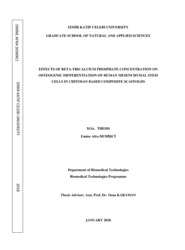Effects of beta -tricalcium phosphate concentration on osteogenic differentiation of human mesenchymal stem cells in chitosan based composite scaffolds
-
Eser Sahibi
Demirci, Emine Afra
- Tez Danışmanı Ozan KARAMAN
-
Tür
Yüksek Lisans
- Yayın Tarihi 2018
-
Yayıncı
İzmir Katip Çelebi Üniversitesi Fen Bilimleri Enstitüsü
- Tek Biçim Adres Http://hdl.handle.net/11469/373
Today, tissue transplant applications are widely used for repair of damaged hard tissue. Despite the gold standard of autografts, interest in synthetic bone grafts produced by tissue engineering techniques is increasing day by day, due to limiting factors such as damage to the tissue site and limited graft availability in allografts, and the risk of developing an immune system response in allografts.Many bioceramic materials, including β-tricalcium phosphate (β-TCP), hydroxyapatite (HA) and calcium sulfate, are widely used in bone tissue engineering. β-TCP has been the most preferred bioceramics in recent years due to its high osteo-compatibility, fast degradation rate and high mechanical strength.
A major disadvantage of existing implant materials is their sintered solid and hard form, which makes it difficult for the surgeon to adapt the surgical graft material to the desired shape during surgery. This causes bone loss and trauma to healthy peripheral tissues and prolonged surgical time. Polymer-ceramic based composite scaffolds are produced to overcome this problem. It is aimed to increase cell adhesion by mimicking the extra cellular matrix with its polymeric character and to imitate bone structure with ceramic character and show osteoconductive and osteoinductive properties.
Within the scope of this study, chitosan based scaffolds with different β-TCP ratios were prepared by freeze drying method. For characterization of the scaffolds produced, morphological characteristics were investigated by Scanning Electron Microscope (SEM) and pore diameters were calculated. At the same time, compression test was performed to determine the mechanical properties.
The biocompatibility of the produced scaffolds was supported by in vitro cytotoxicity and genotoxicity tests. Bone marrow-derived mesenchymal stem cells were used and cultured on scaffolds for the investigation of the effect of β-TCP content on stem cell differentiation. DNA quantification was performed to examine cell proliferation, and SEM analysis was performed to examine cell morphology. In order to examine osteogenic differentiation, the expression of osteogenic specific genes together with ALP analysis on days 7, 14 and 21 was examined.
-
Koleksiyonlar
ENSTİTÜLER
FEN BİLİMLERİ ENSTİTÜSÜ

 Tam Metin
Tam Metin

